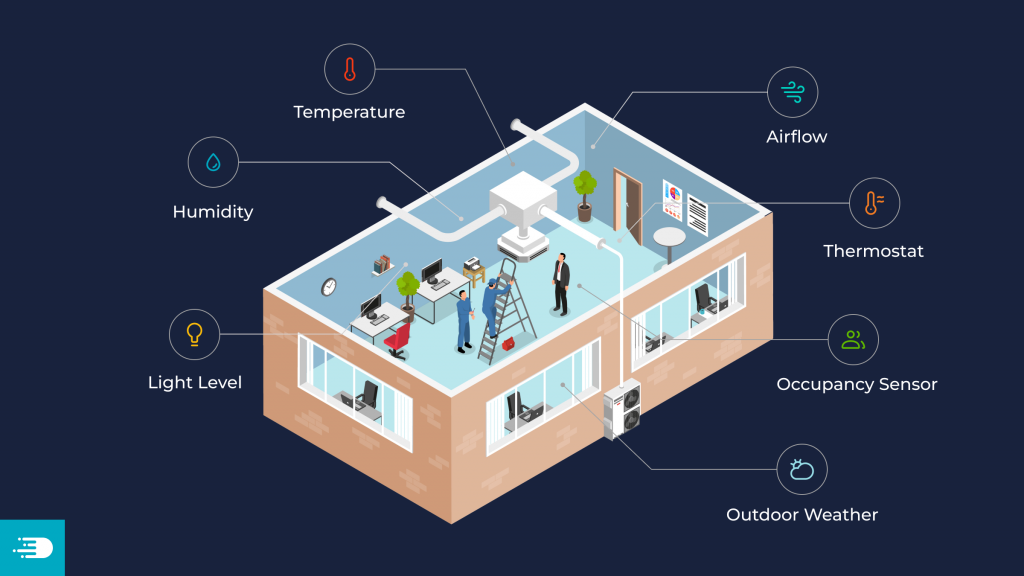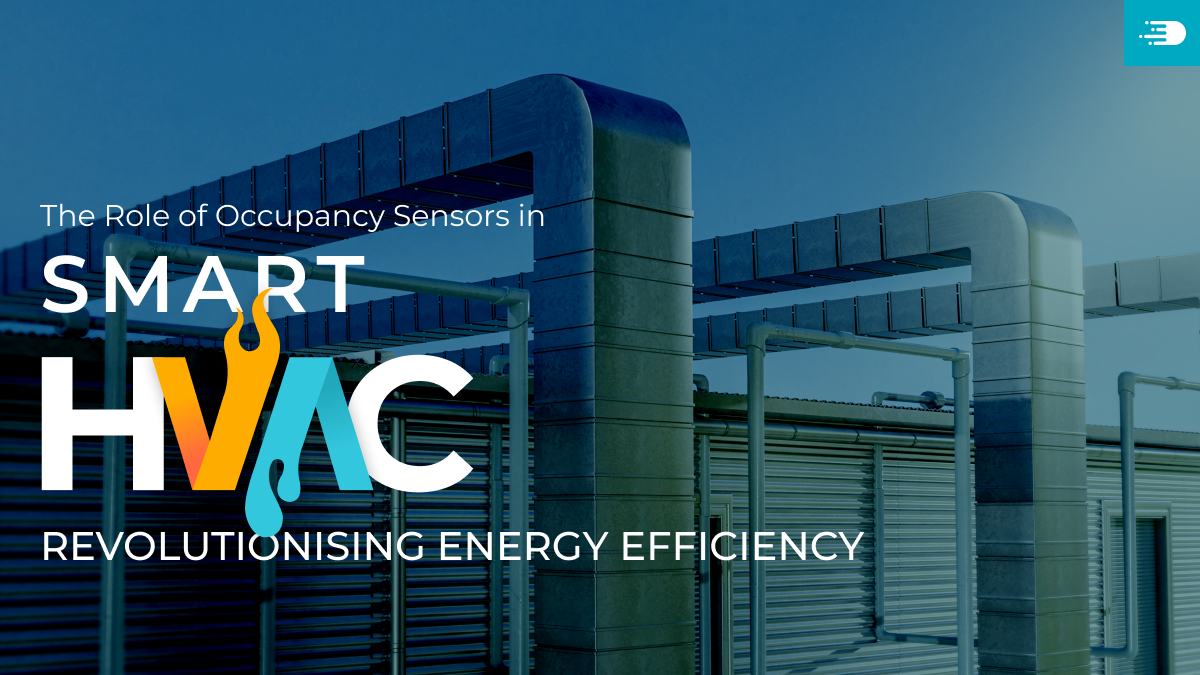Introduction
In today’s rapidly evolving world, pursuing energy-efficient solutions has become increasingly imperative across various industries. HVAC (Heating, Ventilation, and Air Conditioning) systems, significant contributors to energy consumption in residential and commercial buildings, are integral to smart building technologies. Integrating smart occupancy sensors and air quality monitors into HVAC systems is a transformative development as we strive to reduce our carbon footprint and curtail energy costs. These sensors work together to create smart building technologies that optimise indoor environmental quality and occupant comfort. In this article, we delve into the workings of these sensors and explore the multitude of benefits they bring to the forefront of energy efficiency in HVAC systems.
How Occupancy Sensors Enhance Energy-Saving Capabilities of HVAC Systems

Recent years have witnessed a revolution in the HVAC world, with smart occupancy sensors leading the charge in augmenting energy-saving capabilities. Occupancy sensors detect not only the presence or absence of occupants but also their number, automatically adjusting HVAC settings to yield several key benefits:
Automated Control:
Occupancy sensors facilitate the automation of HVAC systems, allowing them to adapt heating, cooling, and ventilation in real time based on occupancy data. This eliminates the need for manual adjustments, ensuring the optimal use of energy resources and conserving energy.
Energy Savings:
Occupancy sensors help prevent unnecessary energy consumption by accurately detecting the presence, absence, and number of occupants. In unoccupied spaces, these sensors can lower HVAC output or even shut down the system entirely, resulting in significant energy savings.
Improved Comfort and Indoor Air Quality:
Smart Occupancy sensors with CO2 monitors maintain ideal indoor environmental conditions by adjusting HVAC settings based on real-time occupancy, guaranteeing comfort while minimising energy waste and ensuring healthy indoor air quality.
Enhanced Lifespan of HVAC Equipment:
With smart occupancy monitoring sensors in place, HVAC systems experience less wear and tear as they operate only when needed and at optimised levels. This prolongs the lifespan of equipment and reduces maintenance costs.
Learning and Adaptation:
Some smart HVAC systems incorporate machine learning algorithms that adapt to users’ preferences and occupancy patterns over time. This means that the system can “learn” when and how to adjust settings to optimise comfort, energy efficiency, and indoor air quality.
Data and Analytics:
Smart HVAC systems equipped with smart occupancy sensors with CO2 monitors, and other smart sensors can collect valuable data on energy usage, system performance, and indoor air quality. This data can be used to identify trends, diagnose issues, optimise system performance, and make informed decisions for further energy efficiency improvements and a healthier work environment.
The Role of Smart Occupancy Sensors in Energy Efficiency
A study by the Department of Energy reveals that heating and cooling account for nearly 40% of energy consumption in commercial buildings. Building owners and operators can significantly reduce energy waste and achieve superior energy efficiency by integrating smart occupancy sensors, and other smart building technologies into HVAC systems.
Key Features and Advantages of Smart Occupancy Sensors
Zoning:
Smart occupancy sensors enable dividing spaces into zones, facilitating customised control of HVAC settings in each area. This ensures energy is directed precisely where it’s needed, reducing unnecessary energy usage in unoccupied zones.
Night Setback:
Many buildings experience reduced occupancy rate during specific hours, such as overnight. Occupancy sensors detect this drop in occupancy and initiate a “night setback” mode, where HVAC systems operate at lower output levels, conserving energy while maintaining minimal comfort.
Task-Specific Control:
In spaces where specific activities are performed, such as conference rooms or individual offices, smart occupancy sensors can tailor HVAC settings to occupants’ needs. This targeted control eliminates energy wastage by avoiding the uniform heating or cooling of the entire building.
Improved Security:
Smart occupancy sensors are commonly used in security systems to detect unauthorised or unexpected movement in an area. They can trigger alarms, notifications, or video surveillance, helping to enhance security measures.
Environmental Impact:
The energy savings facilitated by smart building technologies, including occupancy sensors and CO2 monitors, positively impact the environment by reducing greenhouse gas emissions and the demand for fossil fuels, ultimately contributing to a more sustainable and eco-friendlier world.
Case Studies and Industry Statistics
A notable case study with Hilson Moran, an international design company, demonstrates the efficacy of occupancy sensors in enhancing the energy-saving capabilities of HVAC systems:
In an office building equipped with smart occupancy monitoring sensors, an average energy savings of 30% was achieved compared to buildings with fixed occupancy patterns.
These statistics underscore the significant impact of occupancy sensors and smart building technologies on energy efficiency and cost savings in diverse building environments.
Key Takeaways
Smart occupancy sensors play a pivotal role in enhancing the energy-saving capabilities of HVAC systems. By automating control, optimising energy usage, and providing tailored comfort, these sensors contribute to superior energy efficiency and a reduced carbon footprint. Building owners and operators stand to benefit from lower energy costs, prolonged equipment lifespan, and enhanced occupant satisfaction.
As the drive for sustainability and green building practices continues to gain momentum, occupancy sensors are poised to become an indispensable component of HVAC systems. Their integration paves the way for substantial energy savings, heightened comfort, and a more environmentally responsible approach to heating, cooling, and ventilation in both residential and commercial settings.
Conclusion
Integrating occupancy sensors into smart HVAC control systems offers a gateway to maximising energy efficiency, yielding substantial cost savings and a positive environmental impact. As technology advances, adopting smart HVAC control systems featuring occupancy sensors will become increasingly prevalent. These solutions optimise energy efficiency and provide personalised comfort, marking a win-win scenario for businesses and the environment. By embracing this technology, we can forge a path towards a greener, more sustainable future.
Reference: https://energy5.com/the-role-of-occupancy-sensors-in-smart-hvac-controls-energy-saving-techniques

